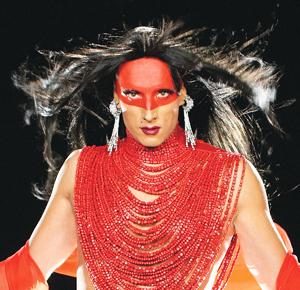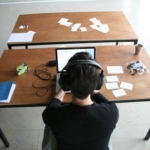If the phrase “native art” conjures visions of stately totem poles and delicate animal etchings, The Power Plant’s current exhibition, Beat Nation: Art, Hip Hop and Aboriginal Culture, will prove eye opening. First presented at the Vancouver Art Gallery in 2012 by co-curators Kathleen Ritter and Tania Willard, the show not only dismantles conventional notions of native art; it questions whether the term should even be used.
“I don’t think you can say native art anymore,” Willard says. “It’s a misnomer to begin with because aboriginal expression is as diverse as our languages and cultures. Art is great when it’s a surprise and makes us think in new ways. Those who hold such stereotypes of native art will be surprised to reconsider the label in the wake of artists working in spray paint, digital music and DJ culture.”
Centred on works that juxtapose aboriginal identity with urban youth culture, the show features nearly two dozen creative voices blending and remixing cultures. Naturally, that meant including queer and two-spirit voices.
“We discussed ideas of heterosexuality and gender discrimination in mainstream hip hop and wanted to make sure we focused on the genre’s more diverse and conscious voices,” Willard says. “Indigenous cultures have recognized many forms of gender, and we tried to honour this in the exhibition by including artists who fall into other categories of gender or sexuality.”
Toronto-based artist Kent Monkman’s video Dance to Miss Chief was a natural fit for the exhibition. Conceived as a music video for his performance character Miss Chief Eagle Testickle’s first dance track, the video blends Monkman’s earlier work Dance to the Berdashe with scenes from German Westerns (an obscure film genre celebrating the country’s obsession with America’s Wild West).
Often appearing nearly nude, save for platform heels and a feather headdress, the outrageous Miss Chief (or “mischief,” depending on your pronunciation) represents both an intersection of traditional aboriginal cultures and contemporary gay identity, as well as a reversal of the objectifying gaze cast on native peoples by Europeans. Miss Chief first appeared in one of Monkman’s paintings before expanding her oeuvre to film and live performance. A music video seemed a natural, if humorous, next step.
“I wanted to play with the idea of creating a music video for this manufactured celebrity who has no real talent,” Monkman says. “I’ve thought of expanding her merchandising dreams to include a fragrance, like other mock celebrities trying to squeeze money from their fame. But I’d rather focus on her political stance. She originated as a nod to the obliteration of native peoples in American history and their disappearance in art history.”
The show hits Toronto as the Idle No More movement snowballs and national media attention is focused on the plight of Canada’s First Nations. Though it was conceived and first presented long before Chief Theresa Spence began her hunger strike, the movement’s politics resonate throughout the show.
“Idle No More is not new,” Willard says. “It’s a resurgence of an ongoing battle for human rights for aboriginal people in this country. As such, the exhibition is heavily informed by these politics, even though it is not directly affiliated with the movement.”
“I’ve been making work on these issues for a long time,” Monkman adds. “Specifically the issue of treaties and how they have been eroded by the Canadian government. They see themselves as a governing body that can just move forward and make any changes they want to legislation that governs native peoples, without consulting or even considering the communities affected.”
As for the movement’s potential effectiveness, Monkman stresses the importance of not losing sight of its real objectives.
“The activists are not inside government, so they can’t change the policies,” he says. “The movement is about raising awareness, and it’s up to the leaders and the policymakers to effect change. A lot of Canadians don’t have any idea and probably don’t really care about the problems First Nations peoples are facing. It’s about raising flags to stop the omnibus bill the government was trying to pass unnoticed, and I think it’s been very effective in achieving that.”


 Why you can trust Xtra
Why you can trust Xtra


